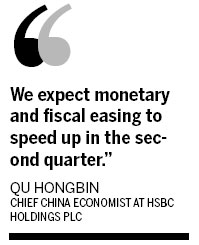 |
|
|
|
|||||||||||
Looser monetary policy provides boost to mitigate contraction
China's manufacturing sector could contract for a sixth consecutive month in April, but at a slower pace because of easing steps by the government, HSBC Holdings Plc said on Monday.
The HSBC Flash Purchasing Managers Index, a preliminary indicator of operating conditions in the domestic manufacturing sector, increased to 49.1 in April from 48.3 in March, showing a rebound in real economic activity, which refers to manufacturing and services, the bank said.
This leading indicator may signal a moderate recovery in the world's second-largest economy, after GDP growth hit a three-year bottom of 8.1 percent in the first quarter, analysts said.
HSBC's estimate is based on monthly replies to questionnaires filled out by more than 420 manufacturing companies' purchasing executives.
According to the bank's report, the rebound was mainly based on increased production, shown by the two-month high of 49.1 in the manufacturing output subindex for April, compared with 47.3 in March.
A reading below 50 means contraction, while one above 50 indicates expansion. New export orders rose to 49.8, the highest in three months, compared with 47.7 in March.
| ?
 |
However, these subindexes were all under 50, which may signal the need for more easing in the coming months to boost economic growth, said Qu.
"We expect monetary and fiscal easing to speed up in the second quarter," he said.
To increase liquidity, the central bank reduced banks' reserve requirement ratios, which reflect the amount of cash that commercial banks hold aside, by 50 basis points in February.
The first loosening of monetary policy, which was in December, ended a tight policy cycle that prevailed for almost three years. In March, the central bank freed up 1.01 trillion yuan ($160 billion) in new loans, the highest amount in 14 months and a month-on-month surge of 32.3 percent.
"The next RRR cut may come in May, with fiscal spending on infrastructure projects picking up," said Zhang Zhiwei, chief China economist at Nomura Holdings Inc.
The economy could still cool further, although the growth of exports was faster than expected thanks to an easing in the eurozone debt crisis, said Zhu Baoliang, chief economist at the State Information Center.
"But the key is to better lead capital into industrial companies, especially medium-sized and small ones," Zhu said. "Otherwise, the money might prefer to chase higher returns in the stock and real estate markets, which can further inflate bubbles."
Zhu attributed the financing problems of companies to the high cost of borrowing, which underscores the need for a market-oriented interest rate mechanism reform and encouraging more private capital to participate in the lending system.
In the second quarter, GDP growth may accelerate to 8.4 percent, which would be 0.3 percentage point higher than the first quarter, with expectations that new export orders may bounce back at a faster rate, said Jing Ulrich, managing director and chairman of global markets, China at JPMorgan.
"The looser monetary policy will take effect in the coming months," she said.
chenjia1@chinadaily.com.cn